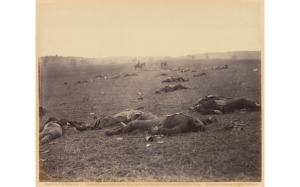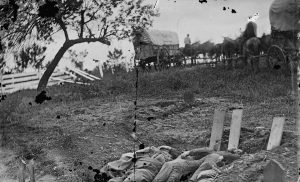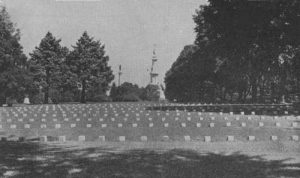“A Harvest of Death”: The Days After Gettysburg

In the days following the Battle of Gettysburg, the most of both the Union and Confederate armies had already left the area. However, approximately 30,000 soldiers of both armies still remained in Gettysburg. About 21,000 of these soldiers were receiving treatment in the hospitals (often people’s homes or barns) or they were still out in the field needing treatment. About 7,000 more lay dead on the recent battlefield awaiting burial as were about 3,000 horses. To put this into perspective, the population of the town of Gettysburg in 1863 was about 2,400 people.[1] Unlike many other battles throughout the war, Gettysburg was accessible to Northern citizens who were not yet exposed to the carnage of war. Gettysburg residents, curious visitors, and even seasoned soldiers were horrified by what they saw.
…I saw a small portion of [the battlefield], but I saw all I wished to. The rebel dead and ours lay thickly together, their thirst for blood forever quenched. Their bodies were swollen, black, and hideously unnatural. Their eyes glared from their sockets, their tongues protruded from the mouths, and in almost every case, clots of blood and mangled flesh showed how they had died and render a slightly ghastly beyond description…I thought I had become hardened to almost anything, but I cannot say I ever wish to see another sight like that I saw on the battle-field in Gettysburg. [2]
With all of the dead and wounded in Gettysburg, the area quickly became an insufferable place to be. A writer for a Philadelphia papers exclaimed on June 6th, 1863:
The air is polluted with a heavy sickening, disgusting stench. Thanks for the heavy rain we have had, carrying off much of the blood, otherwise I do not see how people could live here. As it is, it is the most disgusting atmosphere I ever breathed, or thought it possible human beings could live in.

Something needed to be done. In the days after the battle, it was up to Union soldiers and the residents of Adams County to bury the dead. Ads were placed in the local newspapers stating that “men, horses, and wagons [were] wanted immediately to bury the dead and cleanse our streets in such a thorough way as to guard against pestilence”.[3] Men were buried throughout the fields where they lie, in shallow graves about a foot deep, or in mass graves as quickly as possible in order to clear the area. However, not all men were buried equally. As a Union victory in a northern town, Union soldiers were buried first while the bodies of many Confederate soldiers remained. Additionally, men were killed all throughout the town and so not all were found and buried. These bodies were unfortunately left to swelter in the sun and picked by scavengers including hogs and birds. Even in the months and years following the battle, men buried in shallow graves would not remain buried as the rains washed away the soil or farmers started to plow their fields for the next year’s crop.
Not only were the wounded and dead all throughout the town of Gettysburg visible in the months after the battle, their images were spread throughout the North as well, making Gettysburg one of the more visible battles to those who were not in the area to see it. Photographers such as Alexander Gardner took dozens of photos of the area and about ¾ of the images that he took were of the bodies of soldiers, animals, and mass graves. These images in conjunction with an earlier exhibit opened by Matthew Brady about the Battle of Antietam shocked America and made people realize the ravages of war that led to the indignity of soldiers who fought and died for their beliefs and were left of the field to rot, or were buried in mass, with simply the word “unknown”.[4] This in turn would spark a change in the way these soldiers were buried and remembered.
Prior to 1862, the War Department created smaller cemeteries in areas where needs arose, typically near hospitals, but by 1862, Congress passed legislation that gave the President the capability of purchasing grounds to create a cemetery for soldiers who died in service of their country. This applied only to Union soldiers since the United States had the supplies and means to create these cemeteries while oftentimes the Confederacy did not. Through this measure, five cemeteries were created over the course of the war, but the cemetery created at Gettysburg was unique for its location in the North making it more easily available to Northern citizens during the war.

Building the cemetery began in October 1863 when a committee was formed to purchase land and lead the reinternment of the Union soldiers in Gettysburg. Over the course of several months, about 3,500 soldiers were reinterred onto Cemetery Hill using contractors for a rate of $1.59 per body.[5] The cemetery was dedicated on November 19th, 1863 in which President Lincoln traveled to Gettysburg to recite his now famous address. While a few Confederate soldiers are buried in the cemetery, in the 1870s, efforts were made by Southern Veteran Societies to reinter the Confederate dead in cemeteries thought out the South and these include cemeteries in Virginia, Georgia, and North and South Carolina.
The months following the Battle of Gettysburg put residents and soldiers to the test dealing with an unimaginable amount of death and destruction. Through many emotional and physical trials, many of these men were able to be reinterred and remembered for their sacrifice, though some names and bodies were lost to time. It is inconceivable to many of us what people had to endure 156 years ago, but we can honor and remember those who were forced to experience a time greater than themselves.
[1] Gregory A. Coco. A Strange and Blighted Land: Gettysburg the Aftermath of a Battle. El Dorado, CA: Savas Beatie (1995): 81.
[2] Rosenblatt, Ernie, ed. Anti-Rebel—The Civil War Letters of Wilber Fisk. Croton-on-Hudson, NY: Ernie Rosenblatt (1983): 115-16.
[3] Coco, 85.
[4] Shauna Devine. Learning from the Wounded: The Civil War and the Rise of American Medical Science. Chapel Hill, NC: University of North Carolina Press (2014): 178-179.
[5] Drew Gilpin Faust. This Republic of Suffering: Death and the American Civil War. New York, NY: Alfred Knopf (2008), 100.
Stonewall Jackson should have been there
Gettysburg is amazing rose woods very Erie feel what happened here elliot burriel mapshows areas of burriels ,I’ve been reenacting back 1980s and collect c.w. I cant get enough of armies and these soldiers s.v.
As a Marine Combat Veteran from Desert Storm, I find Civil War history fascinating. It is so tragic that Americans were fighting Americans in Gettysburg and many other locations. We can never allow such a War to take place again on American soil. Semper Fi.
As a former Civil War re-enactor with the 24th Michigan, GETTYSBURG has a very special place in my soul. Many from my unit died or were wounded there on the first day!